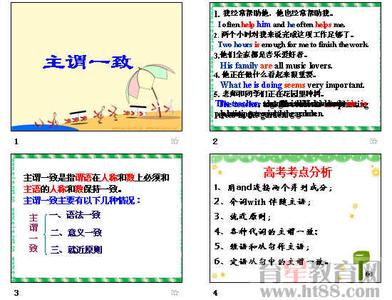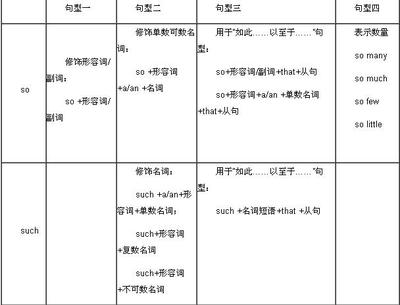在英语句子里,谓语受主语支配,其动词必须和主语在人称和数上保持一致,这就叫主谓一致。寻其规律,大致可归纳为三个原则,即语法一致、逻辑意义一致和就近一致原则。
一、就近一致原则在英语句子中,有时谓语动词的人称和数与最近的主语保持一致。
1. 当两个主语由either …… or, neither …… nor, whether …… or ……, not only …… but also连接时,谓语动词和邻近的主语一致。如:Either the teacher or the students are our friends. / Neither they nor he is wholly right. / Is neither he nor they wholly right?
2. there be句型be动词单复数取决于其后的主语。如果其后是由and连接的两个主语,则应与靠近的那个主语保持一致。如:There are two chairs and a desk in the room.
注意:Here引导的句子用法同上。
二、语法一致原则语法上一致就是谓语动词和主语在单、复数形式上保持一致。
1. 以单数名词或代词、动词不定式短语、动名词短语或从句作主语时,谓语动词一般用单数形式;主语为复数时,谓语动词用复数形式。如:His father is working on the farm. / To study English well is not easy. / What he said is very important for us all. / The children were in the classroom two hours ago. / Reading in the sun is bad for your eyes.
注意:由what引导的主语从句,后面的谓语动词多数情况用单数形式,但若表语是复数或what从句是一个带有复数意义的并列结构时,主句的谓语动词用复数形式。如:What I bought were three English books. / What I say and do is (are) helpful to you.
2. 由连接词and或both …… and连接起来的合成主语后面,要用复数形式的谓语动词。如:Lucy and Lily are twins. / She and I are classmates. / The boy and the girl were surprised when they heard the news. / Both she and he are Young Pioneers.

注意:(1)若and所连接的两个词是指同一个人或物时,它后面的谓语动词就应用单数形式。如:The writer and artist has come. (2)由and连接的并列单数主语前如果分别有no, each, every more than a (an) , many a (an)修饰时,其谓语动词要用单数形式。如:Every student and every teacher was in the room. / No boy and no girl likes it.
3. 主语为单数名词或代词,尽管后面跟有with, together with, except, but, like, as well as, rather than, more than, no less than, besides, including等引起的短语,谓语动词仍用单数形式;若主语为复数,谓语用复数形式。如:Mr. Green, together with his wife and children, has come to China. / Nobody but Jim and Mike was on the playground. / She, like you and Tom, is very tall.
4. either, neither, each, every 或no +单数名词和由some, any, no, every构成的复合不定代词,都作单数看待。如:Each of us has a new book. / Everything around us is matter.
注意:(1)在口语中当either或neither后跟有“of+复数名词(或代词)”作主语时,其谓语动词也可用复数。如:Neither of the texts is (are) interesting. (2)若none of后面的名词是不可数名词,它的谓语动词就要用单数;若它后面的名词是复数,它的谓语动词用单数或复数都可以。如:None of us has (have) been to America.
5. 在定语从句时,关系代词that, who, which等作主语时,其谓语动词的数应与句中先行词的数一致。如:He is one of my friends who are working hard. / He is the only one of my friends who is working hard.
6. 如果集体名词指的是整个集体,它的谓语动词用单数;如果它指集体的成员,其谓语动词就用复数形式。这些词有family, class, crowd, committee, population, audience等。如:Class Four is on the third floor. / Class Four are unable to agree upon a monitor.
注意:people, police, cattle等名词一般都用作复数。如:The police are looking for the lost child.
7. 由“a lot of, lots of, plenty of, the rest of, the majority of + 名词”构成的短语以及由“分数或百分数+名词”构成的短语作主语,其谓语动词的数要根据短语中后面名词的数而定。如:There are a lot of people in the classroom. / The rest of the lecture is wonderful. / 50% of the students in our class are girls.
注意:a number of“许多”,作定语修饰复数名词,谓语用复数;the number of“……的数量”,主语是number,谓语用单数。
8. 在倒装句中,谓语动词的数应与其后的主语一致。如:There comes the bus. / On the wall are many pictures. / Such is the result. / Such are the facts.
三、逻辑意义一致原则逻辑意义一致就是谓语动词的数必须和主语的意义一致(因有时主语形式为单数,但意义为复数;有时形式为复数,但意义为单数)。
1. what, who, which, any, more, all等代词可以是单数,也可是复数,主要靠意思来决定。如:Which is your bag? / Which are your bags? / All is going well. / All have gone to Beijing.
2. 表示“时间、重量、长度、价值”等的名词的复数作主语时,谓语动词通常用单数形式,这是由于作主语的名词在概念上是一个整体,如:Thirty minutes is enough for the work.
3. 若英语是书名、片名、格言、剧名、报名、国名等的复数形式,其谓语动词通常用单数形式。如:“The Arabian Nights” is an interesting story-book.
4. 表数量的短语“one and a half”后接复数名词作主语时,其谓语动词可用单数形式(也可用复数。如:One and a half apples is (are) left on the table.
5. 算式中表示数目(字)的主语通常作单数看待,其谓语动词采用单数形式。如:Twelve plus eight is twenty. / Fifty-six divided by eight is seven.
6. 一些学科名词是以 –ics 结尾,如:mathematics, politics, physics 以及news, works等,都属于形式上是复数的名词,实际意义为单数名词,它们作主语时,其谓语动词要用单数形式。如:The paper works was built in 1990. / I think physics isn‘t easy to study.
7. trousers, glasses, clothes, shoes, 等词作主语时,谓语用复数,但如果这些名词前有a (the) pair of等量词修饰时,谓语动词用单数。如:My glasses are broken. / The pair of shoes under the bed is his.
8. “定冠词the + 形容词或分词”,表示某一类人时,动词用复数。
 爱华网
爱华网



